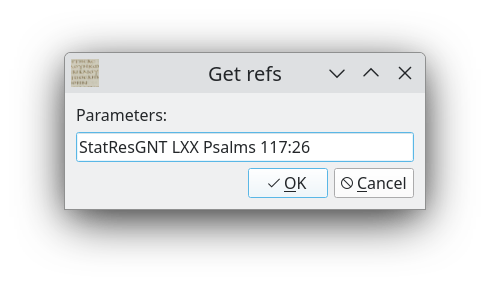29 March 2025
An allusion on Palm Sunday
Does the New Testament (NT) quote the Old Testament (OT), or it just points to certain
passages indirectly, without mentioning any of the source or the fact of quotation?
This is an important question from the reliability point of view of the Bible,
since if we state that the NT quotes the OT but in fact there is no direct quotation,
our statement can be misleading, false, and unsupportive. Making statements on the Bible
is a responsibility, for all audiences who need to face unbiased information to make
considered decisions.
Palm Sunday is approaching, this year it will be celebrated in two weeks. In this blog
entry I point on a couple of NT verses from Matthew 21,1-17 that are partly quotations
and partly allusions. In my Bible study software project bibref,
there is a bugfix that allows visualizing both types, by helping the researcher
to make a difference between the two.
We will focus on four verses: on verse 5 (which is identified as a quotation by Matthew,
by pointing to God and the prophet in verse 4), on verse 9 (which is not introduced
with such identification), on verse 13 (which is introduced by Jesus, pointing to the Scripture),
and on verse 16 (which is introduced by Jesus, again, pointing to the Scripture, for the second time).
Verse 5
The visualized BRST file can be obtained in the statements folder of the checked out project
by issuing the command ./pbrst-cli -g StatResGNT/Matthew/Matthew-21,5.brst | dot -Tsvg > v4.svg:
In KJV, the English text reads (verses 4-5):
All this was done, that it might be fulfilled which was spoken by the prophet, saying,
Tell ye the daughter of Sion, Behold, thy King cometh unto thee, meek, and sitting upon an ass,
and a colt the foal of an ass.
The prophet is not given exactly, and the quotation seems like a composition of two OT passages,
from Zechariah and Isaiah.
Verse 9
This is the BRST code used to explain the correspondence between the OT and NT passages:
Statement Matthew-21,9+75 connects StatResGNT Matthew 21:9+75 21:9-20 (59444-59479, length 36) with LXX Psalms 117:26 117:26-28 (138698-138733, length 36) based on fragment 21:9+75 21:9-20 (59444-59479, length 36) a-z form eyloghmenosoerxomenosenonomatikyrioy matches LXX Psalms 117:26 117:26-28 (138698-138733, length 36) a-z form eyloghmenosoerxomenosenonomatikyrioy unique in Old Testament verbatim providing an overall cover of 100.00%.
The visualized relationship is as follows:
Note that there is no introductory part here (in the figure, there is no light blue box in Matthew).
The English text reads as And the multitudes that went before, and that followed,
cried, saying, Hosanna to the son of David: Blessed is he that cometh in the name of the Lord;
Hosanna in the highest. In modern versification, the OT passage comes from Psalm 118.
This is not mentioned in the OT passage, maybe it was found not to be important by Matthew
who eventually thought the readers of his Gospel were familiar with this psalm.
Interestingly, this allusion is repeated another time in Matthew:
Statement Matthew-23,39+39 connects StatResGNT Matthew 23:39+39 23:39 (69470-69505, length 36) with LXX Psalms 117:26 117:26-28 (138698-138733, length 36) based on fragment 23:39+39 23:39 (69470-69505, length 36) a-z form eyloghmenosoerxomenosenonomatikyrioy matches LXX Psalms 117:26 117:26-28 (138698-138733, length 36) a-z form eyloghmenosoerxomenosenonomatikyrioy unique in Old Testament verbatim providing an overall cover of 100.00%.
This emphasizes the importance of the words expressed by the very great multitude,
and Jesus confirms the validity of that truth:
For I say unto you, Ye shall not see me henceforth, till ye shall say,
Blessed is he that cometh in the name of the Lord.
In fact, this verse of Psalm 118 (or, by using the versification of the software: Psalm 117) is mentioned
in all gospels. The query getrefs StatResGNT LXX Psalms 117:26 in the command line version of bibref gives all occurrences:
LXX Psalms 117:26+9 117:26-50 = StatResGNT I_Timothy 5:18+41 5:18-19 (length=5, pos1=138707, pos2=6317) LXX Psalms 117:26+19 117:26-34 = StatResGNT Mark 9:41+29 9:41-54 (length=11, pos1=138717, pos2=30563) LXX Psalms 117:26+20 117:26-27 = StatResGNT Luke 19:38+37 19:38-30 (length=17, pos1=138718, pos2=75035) LXX Psalms 117:26 117:26-43 = StatResGNT Luke 19:38+8 19:38-55 (length=21, pos1=138698, pos2=75006) LXX Psalms 117:26 117:26-28 = StatResGNT John 12:13+68 12:13-21 (length=36, pos1=138698, pos2=42125) LXX Psalms 117:26 117:26-28 = StatResGNT Luke 13:35+55 13:35 (length=36, pos1=138698, pos2=57426) LXX Psalms 117:26 117:26-28 = StatResGNT Matthew 21:9+75 21:9-20 (length=36, pos1=138698, pos2=59444) LXX Psalms 117:26 117:26-28 = StatResGNT Matthew 23:39+39 23:39 (length=36, pos1=138698, pos2=69470) LXX Psalms 117:26 117:26-22 = StatResGNT Mark 11:9+46 11:10-59 (length=42, pos1=138698, pos2=36385)
(It is important that the user needs to load the database index first by using the addbooks command.)
The same result can be achieved in the GUI version of the program, in the Quotation menu by choosing
Get refs... and entering StatResGNT LXX Psalms 117:26:




(In the GUI version, the Add books option must be chosen first in the File menu on startup.)
Clearly, the first two occurrences are false positive, they are just short parts of the OT text
that are accidentally present in some other NT passages. But the rest, 7 occurences, are correct
matches. This highlights the exceptional importance of this allusion which is repeated again in 2 gospels
(also in Luke, but there one allusion is split into two fragments).
Verse 13
Now, the visualized statement
looks as follows:
In the KJV translation, this reads as And said unto them, It is written, My house shall be called the house of prayer; but ye have made it a den of thieves.
We identify that Jesus recalls the Scripture, without mentioning the two prophets who were actually quoted by Him.
Verse 16
The visualized BRST
file looks like this:
Here, again, there is an introduction: And said unto him, Hearest thou what these say?
And Jesus saith unto them, Yea; have ye never read, Out of the mouth of babes and sucklings thou hast perfected praise?
He does not point to the exact source but just mentions reading.
Quotations or allusions?
Presence of Psalms 117:26 in the NT seems an indisputable fact. It appears, however, always without an introduction.
In fact, all occurrences are in the context of the Psalm Sunday or a recall to that day, given by Jesus.
By having the length of 36 letters (in Mark 11:9-10 there are 6 more letters that seem to be just a random match)
it is exceptionally long and therefore it can be found by a verbatim match search via the getrefs command easily.
So it seems to make sense to insert the statements that describe this relationship, into an official database.
On the other hand, since the NT verses are not explicitly introduced like the quotations usually, these
matches should be identified as allusions but not quotations. In general: If a plausible quotation has
no sign of being introduced by pointing to the Scripture or to a prophet in any form, then that text should be
identified rather as an allusion than a quotation.
Update: Since 23 April 2025 there is a
YouTube video
that demonstrates this blog entry directly in bibref.
Entries on topic internal references in the Bible
- Web version of bibref (12 January 2022)
- Order in chaos (17 January 2022)
- Reproducibility and imperfection (20 January 2022)
- A student of Gamaliel's (23 January 2022)
- Non-literal matches in the Romans (26 January 2022)
- Literal matches: minimal uniquity and maximal extension (31 January 2022)
- Literal matches: the minunique and getrefs algorithms (1 February 2022)
- Non-literal matches: Jaccard distance (2 February 2022)
- Non-literal matches in the Romans: Part 2 (3 February 2022)
- A summary on the Romans (5 February 2022)
- The Psalms (6 February 2022)
- The Psalms: Part 2 (7 February 2022)
- A classification of structure diagrams (15 February 2022)
- Isaiah: Part 1 (19 February 2022)
- Isaiah: Part 2 (26 February 2022)
- Isaiah: Part 3 (2 March 2022)
- Isaiah: Part 4 (7 March 2022)
- Isaiah: Part 5 (15 March 2022)
- Isaiah: Part 6 (23 March 2022)
- Isaiah: Part 7 (30 March 2022)
- A summary (7 April 2022)
- On the Wuppertal Project, concerning Matthew (17 July 2022)
- Matthew, a summary (25 July 2022)
- Isaiah, a second summary (31 July 2022)
- Long false positives (23 August 2022)
- A general visualization (25 August 2022)
- Stephen's defense speech (19 September 2022)
- Statistical Restoration Greek New Testament (31 July 2023)
- Qt version of bibref (11 March 2024)
- Statements on Bible references (5 August 2024)
- Statements on Bible references: Part 2 (2 January 2025)
- Statements connecting LXX and StatResGNT (23 January 2025)
- Deuterocanonical books in the bibref project (5 February 2025)
- Update to LXX 3.0: Part 2 (7 February 2025)
- An allusion on Palm Sunday (29 March 2025)
- Module LXX can be upgraded from 3.0 to 3.2 just with little pain (14 August 2025)
- bibref: German language support (23 August 2025)

|
Zoltán Kovács Linz School of Education Johannes Kepler University Altenberger Strasse 69 A-4040 Linz |